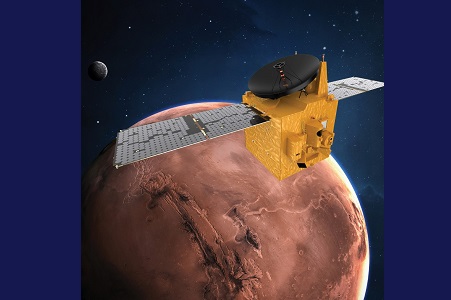 On February 9, the Emirates Mars Mission (EMM), the first Arab interplanetary mission, celebrated the first anniversary of its successful entry into Mars’ orbit and the gathering of a unique trove of Mars observations by the Hope Probe.
On February 9, the Emirates Mars Mission (EMM), the first Arab interplanetary mission, celebrated the first anniversary of its successful entry into Mars’ orbit and the gathering of a unique trove of Mars observations by the Hope Probe.
One year on, “the autonomous spacecraft has achieved historic milestones as part of its mandate to expand our understanding of the Martian planet,” according to the statement from the mission.
The Hope Probe successfully reached Mars’ orbit at 19:42 on February 9, 2021, completing one of the most complex and intricate stages of its mission, after a 493m kilometre, seven-month journey through space.
The probe’s arrival marked “a historic achievement for the Emirates and the Arab world and has resulted in unique and challenging observations of the Red Planet that have not only confounded our understanding of the Red Planet but added immeasurably to our knowledge of Mars’ complex and fascinating atmospheric dynamics,” read the statement.
Sarah bint Yousef Al Amiri, Minister of State for Advanced Technology and Chairwoman of the UAE Space Agency, said: “Tuesday 9 February 2021 has become a historic occasion for the UAE, marking a unique achievement for our young nation. The Hope Probe is an inspiring success story for the youth of the UAE and the Arab world in general and comes as the culmination of a multinational effort to drive the development of our space sector, contribute to our growing space sector and bring new insights into our human understanding of our nearest planetary neighbour – Mars.”
Salem Butti Salem Al Qubaisi, Director General of the UAE Space Agency, stated that February 9, 2021, marks a defining moment in the history of the national space sector. “The successful arrival of the Probe and the unprecedented scientific data it collects contribute to strengthening the UAE’s position regionally and globally in the space sector. In addition, these achievements open up broad prospects for the development and prosperity of the national space sector aimed at boosting its contribution to the UAE’s GDP – as it is one of the most prominent sectors of the future economy based on innovation and knowledge,” he added.
Eng. Omran Sharaf, Director of the Emirates Mars Mission (Hope Probe), noted that the celebration of the first anniversary of the spacecraft’s successful arrival is the culmination of years of tireless and dedicated work by the Emirati project team together with our knowledge partners at the University of Boulder, Colorado. It reflects the UAE’s significant contribution to the scientific progress of humanity, as it provides unprecedented data about the Red Planet.
He said the Probe has registered numerous scientific achievements by observing previously-unknown phenomena. It will continue its scientific mission, which aims to provide the first comprehensive picture of the Red Planet’s climate and atmosphere, benefiting from its unique 25-degree elliptical orbit, which enables it to collect data and high-resolution images of the planet’s atmosphere every 225 hours, or 9.5 days.
Since its arrival, Hope Probe has circled the Red Planet over 170 times, at a rate of one cycle every 55 hours. So far, the data captured by Hope Probe has been made available in two tranches, with a commitment to continue publishing and making new batches available every three months.
The first two batches of scientific data were published in October and January respectively. The first batch, included scientific data gathered from February 9 to May 22 and totalled 110 GB.
The second tranche of data released included 76.5GB of unadjusted data from May 23 to August 31, 2021.
The Hope Probe has made a number of key new observations of Martian atmospheric phenomena, including the elusive discrete aurora on Mars’ nightside, remarkable concentrations of oxygen and carbon monoxide and never-before-seen images of Martian dust storms as they billow across the planetary surface.
On March 15, 2021, the EXI camera captured multispectral images of the oblique view of the heavily cratered region known as Arabia Terra.
Multispectral images (obtained at multiple wavelengths) are very useful when investigating details of the surface and atmosphere of Mars. Longer wavelengths (red images) enhance the appearance of bright and dark surface markings while shorter wavelengths (blue and violet images) enhance atmospheric features (clouds, fogs, and hazes).
On September 15, 2021, the EXI camera system onboard the EMM mission obtained a set of multispectral images of the fully illuminated hemisphere of Mars.
On January 5, 2022, the EXI camera system onboard the EMM mission obtained the half-illuminated view of Mars the sun was just setting near the centre of the disk.
The Hope Probe is scheduled to continue its scientific mission to explore Mars until the middle of 2023, with the possibility of extending it for an additional Martian year (two Earth years).












Add Comment